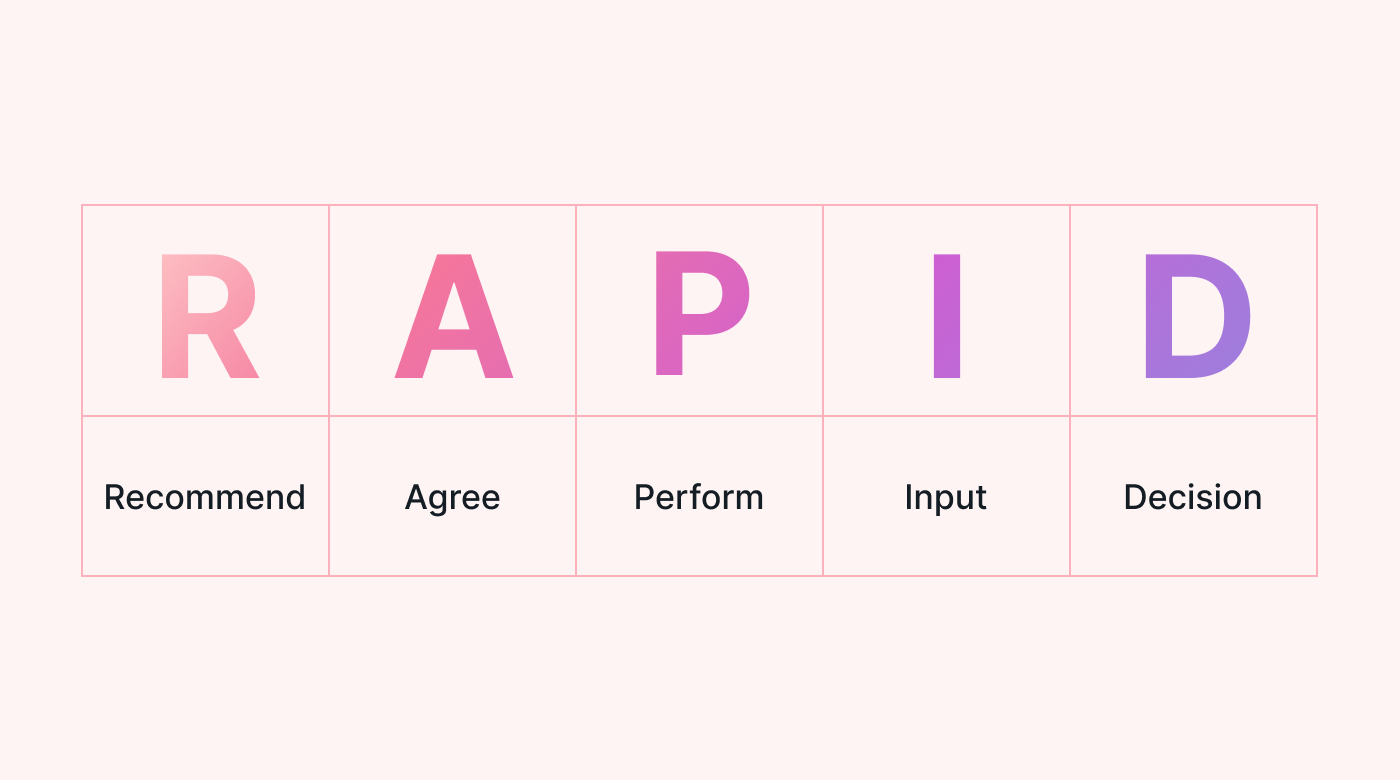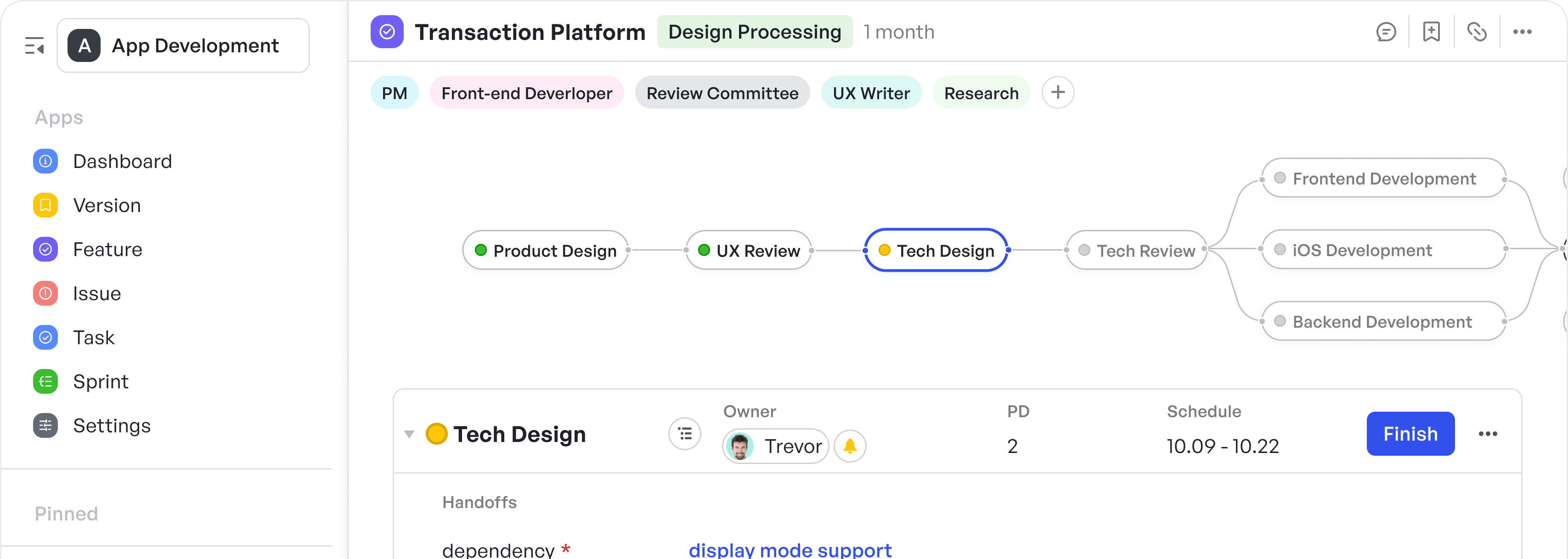Introduction
The RAPID framework for project management is a transformative strategic instrument that enhances project management and governance structures. It delivers clarity regarding role definition and accelerates the decision-making trajectory, granting Project Management Offices (PMOs) a lucid blueprint to navigate complex projects. By delineating precise responsibilities, RAPID effectively addresses prevalent project management challenges including consultative delays, ownership uncertainties, and the suboptimal delegation of tasks. In this guide, we'll explore how PMOs can harness the RAPID framework for project management to streamline processes and improve project outcomes.

250px|700px|reset
What is RAPID Framework? Understanding RAPID’s Roles in the Context of PMO
The RAPID project management framework stands for Recommend, Agree, Perform, Input, and Decide—each representing a critical stage in the decision-making process. Let’s explore each role in the context of how project teams can implement this framework for successful project execution.
Recommend
The key to the success of the project lies in a well-thought-out recommendation. In a PMO setting, project managers often take the lead in gathering data, consulting with experts, holding kick-off meetings, and recommending the next steps. Tools like Meegle can facilitate project tracking, with detail pages providing critical information, and aiding in informed recommendations.
250px|700px|reset
加载中,请稍后
Agree
Stakeholders or sponsors may need to agree on a course of action for a project to progress. Individuals with the 'Agree' responsibility must evaluate recommendations and ensure that they align with the project goals and constraints.
Perform
Project teams, or those designated to 'Perform,' are responsible for the execution of decisions. PMOs can harness workflow management tools like Meegle to assign tasks, sequence workflows, and ensure that decisions made are implemented effectively.
250px|700px|reset
加载中,请稍后
Input
Input is critical, particularly from those with technical or specialized expertise. PMOs can form committees or designate roles for collecting valuable input that informs project decisions. Importantly, engaging platforms that allow collaborative input and document sharing—again, platforms like Meegle can be valuable here—can contribute immensely.
250px|700px|reset
加载中,请稍后
Decide
The 'Decide' role, often held by the project sponsor or top management, carries the responsibility of final approval. A clear hierarchy and defined decision-making protocol within the PMO ensure that the 'Decide' role is empowered to make timely, unequivocal decisions.
How to Implement RAPID Project Management Methodologies
To fully integrate RAPID into your PMO, follow these steps:
- Role Identification:
Start by identifying individuals or groups within your PMO that fit into the RAPID categories. Define clearly written job descriptions to encompass these responsibilities.
- Communication Strategies:
Establish communication lines that reflect the RAPID framework. This means setting up regular meetings, progress reports, and decision logs to keep everyone aligned with their roles.
- Decision-Making Protocols:
Develop protocols that outline how recommendations are made, agreed upon, and decided. This involves timelines, documentation, and processes to follow for each RAPID category.
- Feedback Loops:
Implement feedback mechanisms to ensure that each step within RAPID is executed correctly and any issues are raised immediately and addressed.
Optimizing Issue to Resolution Process with Meegle Template
- Training and Development:
Provide training for all PMO members on the RAPID framework to ensure seamless integration into the project management process.
RAPID Project Management Tool: Using Meegle for Efficient Execution
To make RAPID truly effective, PMOs need a project management tool like Meegle to support each step. Here’s how Meegle enhances the RAPID framework:
- Task assignment and workflow management ensure recommendations are turned into actionable steps.
- Document collaboration and sharing allow seamless input collection from technical experts.
- Real-time tracking of decisions and project progress enables the 'Decide' role to make informed choices.
Conclusion
The RAPID decision-making framework delivers a comprehensive structure for PMOs to optimize decision-making and streamline project processes. By delineating clear roles and responsibilities, it equips project managers with the means to navigate complex decisions and cement the foundation for project success. Adopting RAPID within PMOs will foster a culture of clarity, responsibility, and agility, ultimately driving more efficient and effective project outcomes.
You may also interested in
FAQs
- What is the RAPID Framework in Project Management?
- What is the RAPID Framework in Project Management?
RAPID is a decision-making framework that assigns clear roles and responsibilities to project team members, aiming to streamline processes and clarify who is Responsible, Accountable, has to be Consulted, and Informed about different tasks and decisions, along with who has the Decision-making authority.
- How does RAPID enhance project management?
- How does RAPID enhance project management?
RAPID enhances project management by eliminating ambiguity around decision-making, ensuring that decisions are made swiftly and effectively. It clarifies roles, reducing delays caused by uncertainty and improving project efficiency and accountability.
- Who assigns roles in the RAPID framework?
- Who assigns roles in the RAPID framework?
Typically, the project manager or a lead authority within the project assigns RAPID roles based on team members' expertise, positions, and the specific needs of the project, ensuring that all aspects of the project have clear oversight.
- Can the RAPID framework be applied to any project type or size?
- Can the RAPID framework be applied to any project type or size?
Yes, the RAPID framework is adaptable and can be applied across various project types and sizes. Its primary benefit is in clarifying roles and expediting decision-making, which is valuable regardless of the project scope.
- How does the RAPID framework handle conflicting opinions among members?
- How does the RAPID framework handle conflicting opinions among members?
The framework specifies a single Decision-maker (D), ensuring that, despite consultations and discussions, one person has the authority to make the final decision, reducing stalemates and moving projects forward.
- Is it possible to have multiple accountable persons for a single task under RAPID?
- Is it possible to have multiple accountable persons for a single task under RAPID?
The RAPID framework advises having only one Accountable person per task or decision to ensure clear accountability. However, multiple people can be Responsible for completing the task.
- How do you implement the RAPID framework in an existing team?
- How do you implement the RAPID framework in an existing team?
Implementing RAPID in an existing team involves clear communication about the framework, assigning RAPID roles for each project or task, and training the team on the framework's principles and expectations for each role.
- What metrics can be used to measure the effectiveness of the RAPID framework?
- What metrics can be used to measure the effectiveness of the RAPID framework?
Effectiveness can be measured through metrics such as decision-making speed, clarity in project roles and responsibilities, project delivery timelines, and team satisfaction levels regarding decision processes.
- Can RAPID roles change during a project?
- Can RAPID roles change during a project?
Yes, RAPID roles can evolve as projects progress, reflecting changes in the project’s needs, team members’ availability, or shifts in strategy. It’s essential to keep communication clear and transparent when any role changes occur to maintain project coherence.





